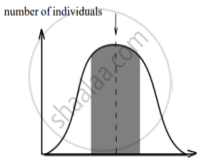Advertisements
Advertisements
Question
Name the law that states that the sum of allelic frequencies in a population remains constant. What are the five factors that influence these values?
Solution
Hardy-Weinberg's principle states that the sum of allelic frequencies in a population remains constant. Five factors are known to affect Hardy-Weinberg equilibrium. These are gene migration or gene flow, genetic drift, mutation, genetic recombination and natural selection.
APPEARS IN
RELATED QUESTIONS
What is the Founder's effect?
According to the Hardy-Weinberg principle, the allele frequency of a population remains constant. How do you interpret the change of frequency of alleles in a population?
Very short answer question.
State the Hardy – Weinberg equilibrium.
Explain how mutations, natural selection and genetic drift affect Hardy Weinberg equilibrium.
Which type of selection explains industrial melanism observed in moth, Biston bitularia ______.
The graphs below show three types of natural selection. The shaded areas marked with arrows show the individuals in the population who are not selected. The dotted vertical lines show the statistical means.
 |
 |
 |
| character Graph A |
character Graph B |
character Graph C |
- What names are given to the types of selection shown in graphs A, B and C?
- After the selection has operated for several generations in the above populations indicated as, Graph A, B and C, graphically illustrate the probable results.
State Hardy Weinberg's principle.
A population of 200 fruit flies is in Hardy Weinberg equilibrium. The frequency of the allele (a) 0.4. Calculate the following:
Frequency of the allele (A).
A population of 200 fruit flies is in Hardy Weinberg equilibrium. The frequency of the allele (a) 0.4. Calculate the following:
The number of homozygous dominant fruit flies.
A population of 200 fruit flies is in Hardy Weinberg equilibrium. The frequency of the allele (a) 0.4. Calculate the following:
The number of homozygous recessive fruit flies.
